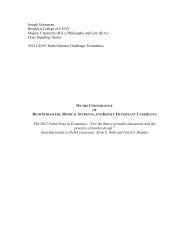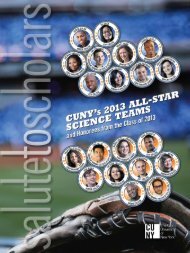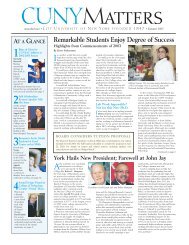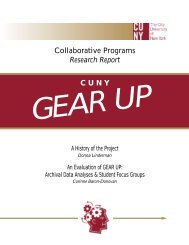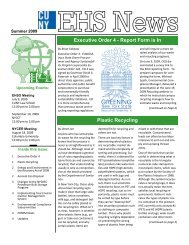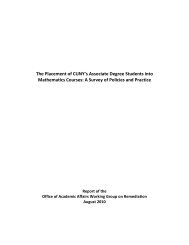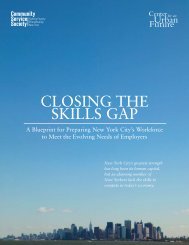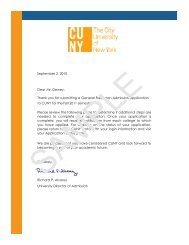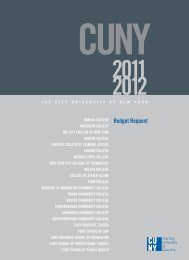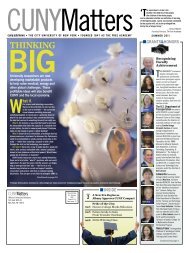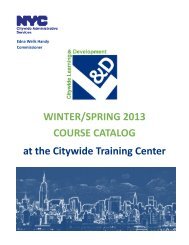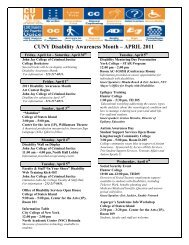CUNY Master Plan 2012-2016
CUNY Master Plan 2012-2016
CUNY Master Plan 2012-2016
Create successful ePaper yourself
Turn your PDF publications into a flip-book with our unique Google optimized e-Paper software.
MISSION PART ONE<br />
The task force also developed implementation guidelines relative to sampling, recruitment and participation<br />
incentives, testing protocol, communications, and report analysis. In fall <strong>2012</strong>, each undergraduate<br />
campus will administer the CLA (or its community college equivalent) to a representative sample of at<br />
least 100 first-time freshmen. The following spring, the instrument will be given to a sample of 100 seniors.<br />
The samples will reflect the full diversity of matriculated students, including remedial and ESL students.<br />
The CLA results will be primarily used as a signaling tool to highlight differences in programs that can<br />
lead to improvements in teaching and learning. The task force has recommended that it be utilized as one<br />
component of a comprehensive set of assessments that include an appropriate mix of locally designed<br />
curriculum-embedded measures and nationally normed or externally derived measures. The CLA is not a<br />
comprehensive measure of general education outcomes nor is it intended to evaluate all aspects of institutional<br />
effectiveness. What it will do is help <strong>CUNY</strong> understand patterns and deal with aspects of a <strong>CUNY</strong><br />
education that may be in need of change. After adopting the CLA, <strong>CUNY</strong> will also be able to join the Voluntary<br />
System of Accountability, an initiative of public four-year universities to supply comparable information<br />
on the undergraduate student experience to important constituencies through a common web<br />
report—the College Portrait.<br />
The University as a National Model for Generation and Use of Data<br />
Over the past four years, <strong>CUNY</strong> has forged ties with several prominent research organizations and<br />
has become a national laboratory for research on an array of academic initiatives. For example, MDRC,<br />
a nationally respected research organization, has conducted assessments of learning communities at<br />
Kingsborough Community College and Queensborough Community College, as well as performancebased<br />
incentives at several colleges. More recently, MDRC has been applying a rigorous experimental<br />
design in its evaluation of the Accelerated Study in Associate Programs (ASAP). <strong>CUNY</strong> has also made its<br />
data resources available to the Community College Research Center, at Columbia Teachers College, to<br />
conduct a series of studies (funded by the Bill and Melinda Gates Foundation) concerning placement into<br />
and progress through remedial sequences at the community colleges. <strong>CUNY</strong>’s Paul Attewell, Distinguished<br />
Professor of Sociology at the Graduate Center, has received Gates funding for a study of remedial<br />
instruction in the University’s summer immersion programs. The central office has itself funded 10<br />
research projects on remedial and credit-bearing mathematics instruction, all using quasi-experimental<br />
designs. Three campuses (Baruch, BMCC, and CCNY), the central office, and the nonprofit organization<br />
Ithaka are collaborating in a randomized assignment, experimental design comparing an online with a<br />
face-to-face version of introductory statistics.<br />
Over the next four years, <strong>CUNY</strong> will continue to build the data infrastructure that underpins its capacity<br />
for research and data-driven decision making. In a consolidated data warehouse, <strong>CUNY</strong> integrates the<br />
information necessary to track from beginning to end the academic career of every degree-seeking student<br />
who has matriculated at a <strong>CUNY</strong> college. The University is currently remaking its administrative<br />
data systems as part of the <strong>CUNY</strong>first project, described in section V of the <strong>Master</strong> <strong>Plan</strong>. As part of this<br />
project, the University will install business intelligence software that will enhance its access to real-time<br />
student data for purposes of assessment and decision support.<br />
29



